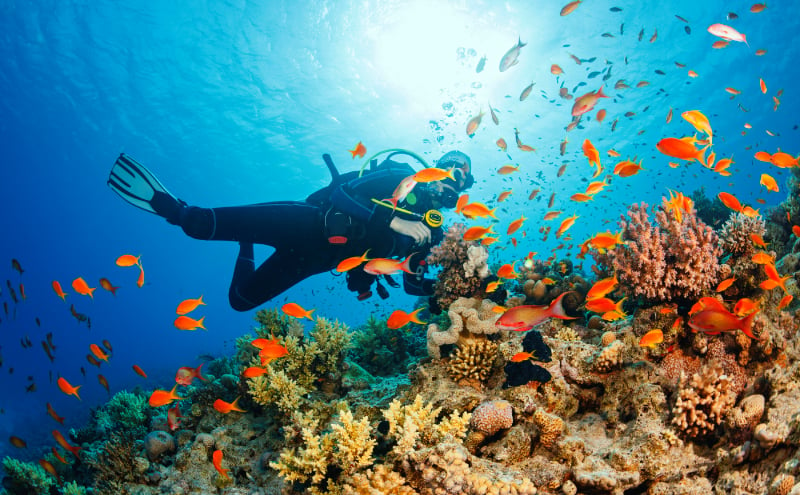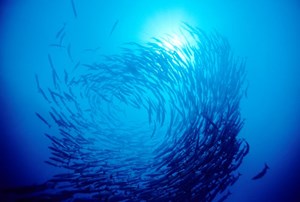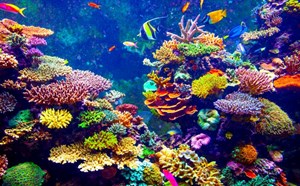
Diving Medicine in the Abstract
Jenny Thacker, MD, FACEP
HCMC Hyperbaric Medicine Fellow 22-23
Paul Jackson Pollock was a prolific painter and artist who made famous the abstract expressionist style “drip technique” in the 1940s. As an adult, he lived in New York City and Springs NY, embracing the bohemian lifestyle. His most famous paintings look like oil paint that has been randomly splattered upon a canvas, perhaps expressive of the turmoil of the times. He signed with Peggy Guggenheim’s gallery in NYC as his first exhibition in 1943. Were these unusual paintings accidents or premeditated masterpieces?
Although diving/hyperbaric medicine is a divergent field compared with Pollock’s, newcomers can feel similar when they encounter a barrage of acronyms and basic diving medicine physiology. Speckled within the diving and hyperbaric milieu are miliary terms and submersive human physiology facts. Many of us are assaulted by physics and pathophysiology, re-learning terms such as vital capacity, Boyle’s Law, and dysbaric osteonecrosis. We strain to bring forth facts learned in medical school or recall human physiological applications garnered a few years distant. A mind can feel like a Jackson Pollock painting, with strings of colorful oil paint drippings splattered across a blank canvas.
It is with this mental amnesia that I had a chance to attend the Undersea and Hyperbaric Medicine Society (UHMS) Physicians Training in Dive Medicine (PTDM) course in 2021 in La Jolla. Due to COVID restrictions, I was participating in the PTDM course with both of the Hennepin County Medical Center (HCMC) Undersea/Hyperbaric Fellows from 2020 and 2021. What fun! Basically, the ghosts of hyperbaric past, present, and future were gathering at the same location to learn hyperbaric theory as pertaining to dive medicine. The aim of the PTDM course is to prepare physicians to successfully treat diving accidents and illnesses within the hyperbaric oxygen.
The PTDM course is a an 80-hour intensive hyperbaric diving course, aimed for physician-level learning. In the past few years, Dr. Richard Sadler and Peter J. Witucki, MD, FACEP, have organized a new immersive course in La Jolla to replace the NOAA 80-hour course that used to take place in Seattle. There are many types of physicians taking the PTDM course- hyperbaric fellows, military fellows, foreign physicians, technical divers, interested recreational divers, etc. Some attendees have emergency medicine as their background, but a lot are from other specialties- surgery, anesthesiology, internal medicine, pulmonology/critical care, family practice, etc.
Day 1 of the PTDM course introduces the learner to basics of dive physics, oxygen toxicity, and myringotomy technique (with model practice). Then over the first week, a “who’s who” of lectures ensued by accomplished and well-recognized international faculty such as Dr. Simon Mitchell, Dr. Karen Van Hoesen, Dr. Chris Tomaszewski, Dr. Tom Neuman, Dr. Peter Lindholm, and Dr. Richard Moon. Other first-week lectures included decompression illness theory, non-pulmonary barotrauma, hyperbaric chamber operations, critical care topics, and closed-circuit rebreather learning.
A full day spent at Hyperbaric Modular Systems (a manufacturer of hyperbaric chambers) exposed the course attendees to a commercial hyperbaric chamber SIM/procedure lab experience, which was definitely a highlight. We learned about A- vs B- vs C-type hyperbaric chambers plus practiced critical care simulation cases. HMS chambers from the past littered their enormous facility, including a monoplace chamber said to have belonged to Michael Jackson! SIM sessions regarding hyperbaric emergencies brought classroom learning into the forefront of our cerebral matter. Later in the first week, hands-on sessions at the outdoor pool taught the attendees about SCUBA basics, underwater search techniques, dry suits, water recovery, and full face mask/underwater communications.
Each evening during the PTDM course, we took an exam that tested the concepts of the day, for a total of 11 quizzes. Sometimes the questions were summary and review, other times they were complicated calculations. The difficulty of the exams varied without rhyme or reason, giving course attendees the “Jackson Pollock experience.” Similar to his paintings, the stream of diving facts stumbled around in our heads until we could finish the daily exam successfully. Although sometimes difficult, the quizzes helped to crystallize complicated topics and provided a daily review.
The evening of the sixth day provided attendees a social opportunity with a banquet and guest lecture, complete with a sit-down meal and refreshments. Day 7 was a welcome day off, where the attendees had personal time. Some PTDM students were excited to have a day of beach time for R and R, whereas others went for a long trail run/hike, did shopping, visited Balboa Gardens, or spent time in La Jolla. A few went SCUBA diving or snorkeling at La Jolla Cove, trying to avoid the sea lion/pelican stink, as well as potential parking tickets.
Week two of the PTDM course introduced advanced diving concepts, building upon the basics. Attendees were a bit refreshed after having a full 24 hours to decompress. We were ready to tackle advanced concepts during the second week of the course: AGE physiology, heliox, dive tables/computers, Sur2D, sat diving, hyperbaric physics, and treatment tables. A visit to the Scripps National Laboratory and the San Diego Aquarium helped to break up the advanced-concept lectures. Fitness-to-dive (FTD) was briefly touched upon in a full-morning session. Afternoons were speckled with lectures plus additional outdoor pool SCUBA sessions and breath-hold stations. By the end of week two (day 11 of the course), all of these amazing diving concepts were swimming in our supersaturated cerebri. Pens had run dry, attendees were homesick, and CME fatigue had settled in. A little group bonding at the hotel bar provided respite before departure home. The PTDM course is DMAC level 2D certified, and provides the attendee with 80 hours of CME over 11 days. It’s an experience that is intense, but satisfying.
Fast forward one year, when as an Undersea and Hyperbaric Fellow at HCMC, I was able to attend the Medical Examiner of Divers (MED) course in September 2022 in New Orleans. This course is also directly taught by UHMS clinicians, but has a different focus: namely to teach providers how to medically assess divers. This course prepares physicians to examine commercial, recreational, research, and related divers (such as public safety), determining if they are fit-to-dive (FTD). Physicians and advanced practice providers from various US programs attend this 4 day-course to learn the specifics of evaluating divers from a safety standpoint after evaluation of patient training and past medical history. All of the attendees, most of whom have not completed the PTDM course, are there to learn and obtain a DMAC level I certification. These physicians/providers are also from varying backgrounds: occupational medicine, pulmonology, family practice, internal medicine, emergency medicine, hyperbaric fellows, etc. Most of the students in this course are working or interested in working in occupational medicine dive clinic, and fewer emergency medicine doctors were represented.
Jackson Pollock also painted abstract expressionism paintings, exploring topics such as the unconscious and surrealism. These paintings expressed his emotions via unique landscapes and figures, some of which featured recognizable subjects. Day 1 of the MED course feels similar, in that diving physiology and physics is covered, but the concepts are decipherable and recognizable. Day 1 might be a review for anyone who is experienced in diving or hyperbaric physiology (or has taken the PTDM course). However, day 2 of the course focuses on diving pathophysiology, and covers both long-term and immediate effects of dysbarism. Day 2 of the MED course branches from the PTDM course as there is a ½ day tour of Triton Commercial Dive Center, exploring the safety of divers utilizing a team approach. Each team member on the commercial diver team explained his/her duties, and how teamwork encourages safety. Later how to perform a detailed diving physical examination was covered, including an extensive neurological evaluation. Just like the PTDM course, there was a UHMS review quiz after each day’s learning session, to be performed by the course attendee on their own.
Day 3 of the MED course is where this experience diverges from the PTDM course. Commercial diving assessments are paramount, and the basics of pulmonary function tests, audiograms, and a detailed neurological examination are taught. Years forgone in residency come rushing back, as practical knowledge becomes chief. Medications, ECG/ECHO findings, and PFOs are covered in detail, as well as other pertinent pathophysiology. DMAC and ECHM and ADCI acronyms are thrown around like popcorn bursting from its kernel. Commercial diving FTD requirements are contrasted with those in the recreational, scientific, and public safety domains. Late day 3 and day 4 of the MED course emphasize integration of all the above concepts by reviewing cases. Participants get to practice what they have learned in a case-based format, bouncing ideas and answers off the MED course faculty. The goal for most attendees is to obtain DMAC/EDTC level I certification to examine divers, which is valid for a period of five years from the date of e certificate issue.
In summary, the MED course does have overlap with the PTDM course, but the focus of the courses is completely different. The MED course emphasizes teaching attendees how to perform FTD evaluations such that patients hopefully avoid diving accidents leading to permanent disability. In essence, this is the primary care clinic of the diving world. In contrast, the PTDM course teaches physicians how to treat decompression illness, plus prepares attendees to become diving medical physicians. The PTDM course focuses on the why and how to treat dysbarism/decompression illness, exploring the unique pathophysiology of the submersive aquatic environment. Hyperbaric chambers are emphasized as the treatment for decompression illness (whether from iatrogenic causes or SCUBA) or medical diseases such as necrotizing fasciitis, carbon monoxide poisoning, and diabetic foot wounds.
Both courses have value and are complementary for UHMS Undersea/Hyperbaric Fellows. One of Jackson Pollock’s most famous paintings is “Convergence,” in which a collage of drip paintings is spattered with recognizable assorted colors and shapes. After completing the two complementary courses, I feel as though my diving knowledge has converged, such that I can assess a diver to both avoid and treat diving disorders. Both courses were some of the best CMEs I have ever attended with regard to value and quality of instruction.
| PTDM COURSE | MED COURSE | |
|
Length of Course |
11 days |
4 days |
|
CME credit/certification |
83 hours AMA CME |
32 hours AMA CME |
|
Cost of Course |
$1,800-$3,000 |
$720-$1,200 |
|
Location |
La Jolla, CA |
New Orleans, LA |



